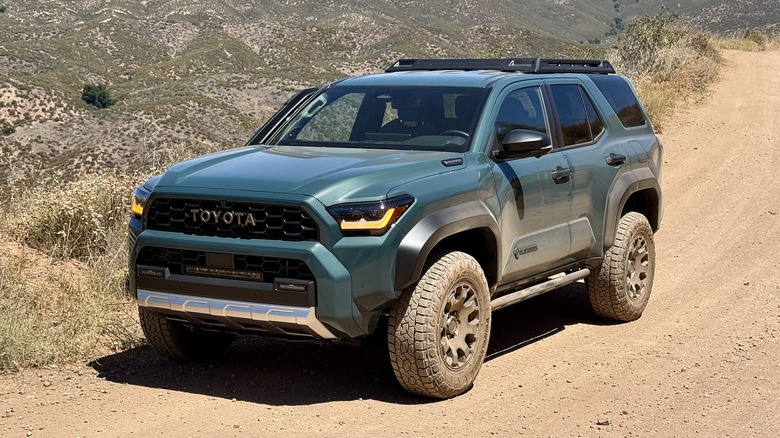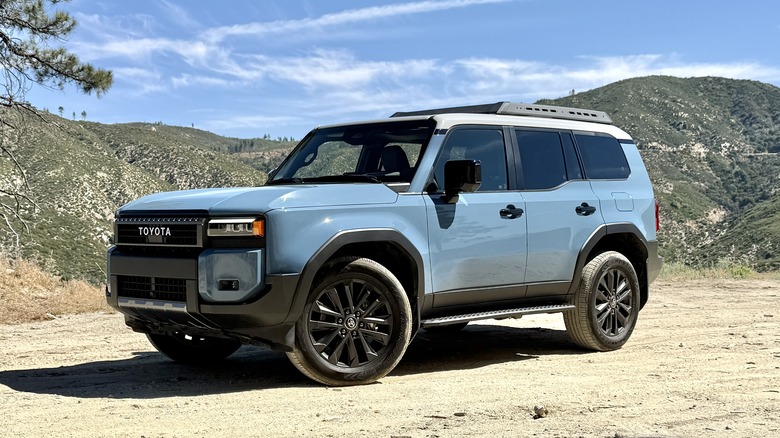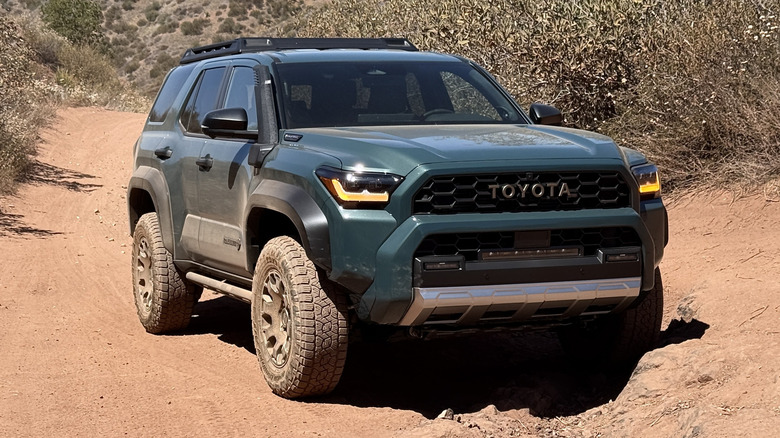4Runner Vs. Land Cruiser: Which Is Better For Off-Roading?
Both the Toyota 4Runner and the Land Cruiser have been redesigned recently, and with both SUVs, there's a lot to like. The Land Cruiser took a three-year sabbatical from dealership showrooms, but it was reintroduced in the U.S. as a 2024 model riding on Toyota's TNGA-F (Toyota New Global Architecture) global truck platform. It sports fresh styling that's both rugged and retro. In our recent test of the Land Cruiser, it performed well, getting top marks for its hybrid powertrain and its baked-in off-road prowess.
The 4Runner got a complete overhaul for 2025 as well. It rides on the same TNGA-F platform, with updated powertrains, a similarly fresh new look, and some serious off-road chops. With a lot of crossovers in their prices and performance, it's a tough decision between these two. The 4Runner has a wide selection of trim levels and an optional third row for big families, but the Land Cruiser offers a bit more refinement.
I've been testing vehicles on- and off-road for years, with lots of experience in the dirt. I've also had the opportunity to test both the Land Cruiser and the 4Runner. Both the Toyota SUVs are extremely capable, but if off-roading is your top priority, the 4Runner is likely the better choice. We'll get into the minutiae of available equipment and the static numbers, but from a test-driven perspective, the 4Runner is generally more focused on off-roading adventures and in its top trims it's better equipped to take you off the beaten path.
Power and off-road capability by the numbers
The base trims of the 4Runner come with Toyota's turbocharged 2.4-liter four-cylinder engine that produces 278 horsepower and 317 lb-ft of torque. The upgraded engine, known as the i-Force Max, adds a hybrid system to the mix. Power output goes up to 326 hp and 465 lb-ft. It's an exact match for the Land Cruiser which uses the same powertrain, but with the Land Cruiser it's the only option. In both SUVs, the added torque of the hybrid system makes for effortless off-roading and impressive on-road acceleration. In that department, it's virtually a tie.
Off-road capability though, as it is with all SUVs, is heavily influenced by approach and departure angles. Comparing these two SUVs, the Land Cruiser wins out in most scenarios. On both the LC's trims, it has an approach angle of 32 degrees and a departure angle of 22 degrees. That's significantly better than the 18/22 degrees offered by base trims of the 4Runner. But on the top-dog TRD Pro and Trailhunter trims, the 4Runner takes the lead, with approach and departure angles of 33 and 24 degrees, respectively. It's a small difference, but it's enough to keep you from getting hung up on some obstacles. Another win for the 4Runner is ground clearance. The Land Cruiser checks in at 8.7 inches, but the top-trim 4Runners have 10.1 inches –a seriously significant difference when it comes to keeping the underside clear of scrapes.
Pricing differences and equipment
The 4Runner is available in a wide variety of trim levels, and there's a big delta between the base and top models. The Land Cruiser, on the other hand, is as simple as it gets — there are only two trim levels and two prices. Here's how that all breaks down. The Land Cruiser starts at $58,195 (including $1,495 destination fee) for the base 1958 trim level. The upper standard trim level has an MSRP of $62,965. For the extra money you get Rigid fog lights, roof rails, a power liftgate, and the larger 12.3-inch infotainment screen, but both most of the important off-road goodies like skid plates, and full-time four-wheel drive. Toyota's Multi-Terrain Monitor (their 360-degree camera that can be used on the trail) is part of the upper trim level, though, so dedicated off-roaders will likely consider the upgrade.
With the 4Runner, it's more of a choose-your-own-adventure setup. Base SR5 models start at $42,765 but come with rear-wheel drive (not very off-road friendly). Other trims, however, like the TRD Off-Road, the TRD Pro and Trailhunter all add serious equipment and buyers can pick the trim level that best suits their needs. Top trims get big all-terrain tires, added skid plates and underbody protection, unique bumpers for extra clearance, and specialized shock absorbers with piggyback reservoirs. On the top trim levels, the added 4Runner capability will cost you, with TRD Pro and Trailhunter models checking in at $68,895, but for serious wheeling, it's worth the price.


